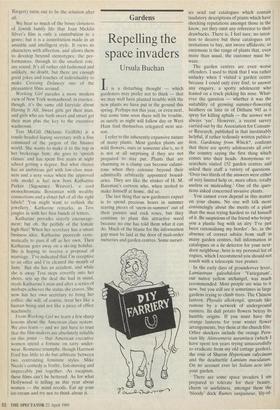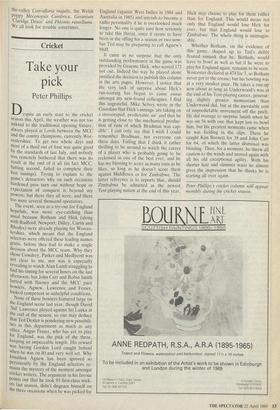Gardens
Repelling the space invaders
Ursula Buchan
It is a disturbing thought — which gardeners may prefer not to think — that we may well have planted trouble with the new plants we have put in the ground this spring. Perhaps not this year, or even next, but some time soon there will be trouble, as surely as night will follow day or West Ham find themselves relegated next sea- son.
I refer to the inherently expansive nature of many plants. Most garden plants are wild flowers, ours or someone else's, so it is not at all surprising if they are not prepared to stay put. Plants that are charming in a clump can become calami- tous when they colonise beyond their admittedly arbitrarily appointed bound- aries. They are like the stinker of H. M. Bateman's cartoon who, when invited to make himself at home, did so.
The last thing that new gardeners expect is to spend precious hours in summer tearing pieces of 'snow-in-summer' out of their pansies and rock roses, but they continue to plant this attractive weed because no one has told them what it can do. Much of the blame for the information gap must be laid at the door of mail-order nurseries and garden centres. Some nurser- ies send out catalogues which contain laudatory descriptions of plants which have shocking reputations amongst those in the know, yet they omit any reference to their drawbacks. There is, I feel sure, no inten- tion to deceive but these catalogues are invitations to buy, not sworn affidavits; so enormous is the range of plants that, even more than usual, the customer must be- ware.
The garden centres are even worse offenders. I used to think that I was rather unlucky when I visited a garden centre because I could only ever find, to answer any enquiry, a spotty adolescent who leaned on a truck picking his nose. What- ever the question — whether it was the suitability of growing summer-flowering heathers on lime or of Dithane 945 as a spray for killing aphids — the answer was always 'yes'. However, a 'recent survey carried out by the Association for Consum- er Research, published in that inestimably helpful, if rather tediously written publica- tion, Gardening from Which?, confirms that there are spotty adolescents all over the country saying the first thing which comes into their heads. Anonymous re- searchers visited 152 garden centres and asked their staff a variety of questions. 'Over two thirds of the answers were either of very limited help or, more often, totally useless or misleading.' One of the ques- tions asked concerned invasive plants.
You cannot even depend in this matter on your chums. No one will talk more convincingly about the merits of a plant than the man trying hardest to rid himself of it. Be suspicious of the friend who brings you a plastic bag with an airy 'I've just been rationalising my border'. So, in the absence of correct advice from staff in many garden centres, full information in catalogues or a lie detector for your next- door neighbour, here is my personal list of rogues, which I recommend you should not touch with a telescopic tree pruner.
In the early days of groundcover fever, Lamiastrum galeobdolon 'Variegatum', our native yellow archangel, was much recommended. Most people are wise to it now, but you still see it sometimes in large gardens trying to climb trees. The Chinese lantern, Physalis alkekengii, spreads like rumour by a network of underground runners. Its dull potato flowers betray its humble origins. If you must have the orange lanterns for your winter flower arrangements, buy them at the church fête. Other shockers include the orange Peru- vian lily Alstroemeria aurantiaca (which I have spent ten years trying unsuccessfully to eradicate from my old cottage garden), the rose of Sharon Hypericum calycinum and the deadnettle Lamium maculaturn. On no account ever let Sedum acre into your garden.
There are some space invaders I am prepared to tolerate for their beauty, charm or usefulness, amongst them the 'bloody' dock Rumex sanguineus, lily-of- the-valley Convallaria majalis, the Welsh Poppy Meconopsis Cambrica, Geranium 'Claridge Druce' and Phlomis russelliana. We all look for trouble sometimes.



































































 Previous page
Previous page